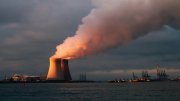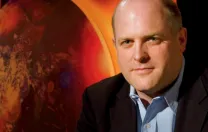Heinz professor of environmental policy John Holdren, who holds a joint appointment in the Faculty of Arts and Science’s department of earth and planetary sciences, counts himself among the environmentalists who believe a contribution from the expansion of nuclear power—if its drawbacks can be overcome—would help meet the need for carbon-free electricity in a climate-constrained world. “Nuclear power provides about one-sixth of the world’s electricity today,” generated by 440 reactors, he notes. In the near future, as older power stations are taken off-line, nuclear’s share of global electricity production will fall precipitously unless new plants are built.
|
In response to this forecast, Holdren and a group of colleagues from MIT asked the question, “If we are going to need nuclear power, what is the safest, most cost-effective way to retain the option to use this resource?” Their answer, outlined in a 2003 report called The Future of Nuclear Power, identifies four key challenges to the industry: high cost, waste disposal, safety (which in a post-9/11 world includes the possibility of terrorism), and weapons proliferation.
Nuclear power has always been expensive because of the capital costs associated with starting up a plant. “Coal eats nuclear’s lunch over 20 to 30 years unless the carbon output of fossil-fuel-burning power plants is taxed at something like $100 per ton,” Holdren says. Today, electricity generated by a nuclear power plant costs about 6.4 cents per kilowatt hour (kwh), as compared to 4.5 to 5 cents per kwh for coal and 3.5 to 4 cents per kwh for natural gas, Holdren explains. Carbon taxes would induce the market to control carbon-dioxide emissions, and many energy producers are already preparing for the day when those taxes arrive. But even if costs were equivalent, a renaissance in nuclear power would face obstacles. In 1983, Graham Allison, then dean of the Kennedy School of Government, and Albert Carnesale, then professor of public policy there, wrote an essay describing the dilemma faced by a utility director weighing whether to build a coal or a nuclear power plant. In their hypothetical scenario, even when nuclear power is cheaper, the director chooses a coal plant because of the political uncertainties surrounding the nuclear alternative. But today, Allison believes that the balance has changed. “The combination of liability relief, fast-tracking of the regulatory approval process, and the introduction of standardized reactor designs in the energy legislation passed last summer make it likely that we are going to have some new nuclear power plants,” he says.
Holdren notes that cost-competitiveness is not the whole story, however. “What we do with nuclear radioactive waste is not a solved problem,” he says. There are engineering questions about the massive storage repository proposed for the Nevada desert. Certainty about its ability to keep groundwater supplies safe falls off after 10,000 years—while the facility needs to function as planned for several hundred thousands of years. And the space is already too small to accommodate even the lifetime output of this country’s existing 104 nuclear power plants.
Holdren believes the toughest problem facing nuclear power today is not waste storage, but breaking the energy/terrorism link. Though modern reactors are operationally 10 to 100 times safer than the designs at Three Mile Island or Chernobyl, he says, nuclear power plants were not built with terrorists in mind. Allison, perhaps the world’s leading expert on nuclear security, agrees: “The idea that suicidal terrorists would come in groups of 20 was not the basis on which nuclear power plants and their security systems were designed,” he points out. “Nevertheless, the chances of an aircraft penetrating the dome of a reactor and causing a meltdown are pretty slim because it has got to hit in just the right spot.” But Al Qaeda looked into targeting nuclear plants with airplanes, he says, and has never taken them off their lists.
An act of terrorism at a nuclear power plant would be analogous to a big dirty bomb, says Allison. “A dirty bomb is a blast in which some radioactive material gets pulverized and then spewed into the atmosphere. Mostly what this does is cause panic.” Some people will get a dose of radiation at a level that would increase the risk of cancer in 25 years, and a few might suffer radiation poisoning, which at high doses can be fatal. Dirty bombs make big messes, and may require massive relocations, as at Chernobyl, but they pale by comparison to the primary threat that Allison has written about in Nuclear Terrorism: The Ultimate Preventable Catastrophe—the possibility that terrorists might get hold of and detonate a nuclear bomb in a major city. “What does a nuclear power plant like Seabrook [in New Hampshire] have to do with that?” asks Allison. “Essentially zero. Not zero, but essentially zero.”
Not all nuclear power plants are light-water reactors like Seabrook, however, and Holdren and others have warned that their nuclear fuels and wastes do present a security risk, especially as they are handled in some foreign countries. Unfortunately, any country that can enrich natural uranium to 2 to 3 percent (the concentration needed to fuel a power plant) can easily use those same machines to enrich the U-235 to 80 or 90 percent, the concentration needed for a nuclear bomb.
A similar vulnerability surrounds the spent fuel that comes out of a reactor. Plutonium in the spent fuel is easily separated from other waste through chemical processing and, like the uranium, can be used to make a nuclear bomb. France and Japan, on the other hand, routinely extract and reprocess plutonium for reuse as reactor fuel, but the dual-use potential of this process has led Holdren and his coauthors to recommend a “once-through fuel cycle” in which the spent fuel is not reprocessed, but instead goes directly into a storage repository.
Keeping bomb-making material out of the hands of all but the existing nuclear states has been a guiding principle in diplomatic efforts to restrain North Korea’s and Iran’s nuclear programs, for example, without denying those countries the right to operate nuclear power plants peacefully. “If the world is going to have a lot more nuclear power plants,” says Allison, “you are going to have to have some arrangement for supplying fuel credibly and for taking it away that doesn’t require everybody getting into the business [of making it] themselves.” He points out that Mohamed ElBaradei, director general of the International Atomic Energy Agency (IAEA) “is trying to create a neutral fuel bank… that would guarantee countries like Iran their fuel.” This proposed international arrangement is called the assured nuclear fuel cycle. Allison notes that the United States and Russia “have agreed to donate several tons of uranium as the first installment of this fuel bank.”
Could terrorists actually acquire enough material to build a bomb? ElBaradei, who with the IAEA was awarded the 2005 Nobel Peace Prize, was asked this question on a recent visit to Harvard. “In the last 10 years,” he replied, “I’ve seen 200 cases of nuclear material being smuggled across borders. So far, not enough to build a nuclear bomb.” Yet it could happen, he said. “This is a world in denial.”
From the wider environmental perspective, meanwhile, even a tenfold expansion in nuclear capacity by 2100 would by itself barely reduce the atmospheric burden of CO2—from a projected 900 ppm (parts per million) to 820 ppm, both catastrophically higher than today’s concentration of 380 ppm, according to Daniel Schrag. But the options for addressing climate change—nuclear power, renewable energy sources, carbon sequestration, and increased energy efficiency—are few. As Holdren and his coauthors wrote, “In our judgment, it would be a mistake to exclude any of these four options at this time.”







